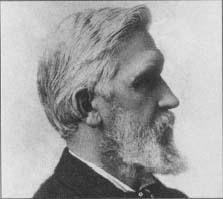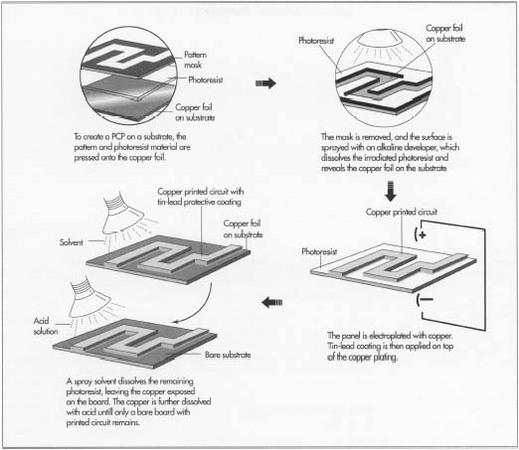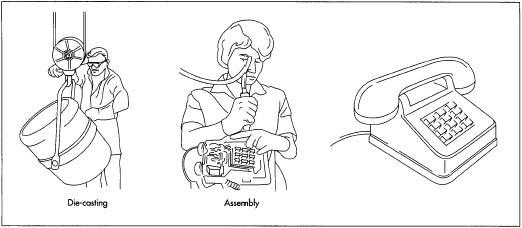Telephone
History
Throughout history, people have devised methods for communicating over long distances. The earliest methods involved crude systems such as drum beating or smoke signaling. These systems evolved into optical telegraphy, and by the early 1800s, electric telegraphy. The first simple telephones, which were comprised of a long string and two cans, were known in the early eighteenth century.
A working electrical voice-transmission system was first demonstrated by Johann Philipp Reis in 1863. His machine consisted of a vibrating membrane that opened or closed an electric circuit. While Reis only used his machine to demonstrate the nature of sound, other inventors tried to find more practical applications of this technology. They were found by Alexander Graham Bell in 1876 when he was awarded a patent for the first operational telephone. This invention proved to revolutionize the way people communicate throughout the world.
Bell's interest in telephony was primarily derived from his background in vocal physiology and his speech instruction to the deaf. His breakthrough experiment occurred on June 2, 1875. He and his assistant, Thomas Watson, were working on a harmonic telegraph. When a reed stuck on Watson's transmitter an intermittent current was converted to a continuous current. Bell was able to hear the sound on his receiver confirming his belief that sound could be transmitted and reconverted through an electric wire by using a continuous electric current.
The original telephone design that Bell patented was much different than the phone we know today. In a real sense, it was just a modified version of a telegraph. The primary difference was that it could transmit true sound. Bell continued to improve upon his design. After two years, he created a magnetic telephone which was the precursor to modern phones. This design consisted of a transmitter, receiver, and a magnet. The transmitter and receiver each contained a diaphragm, which is a metal disk. During a phone call, the vibrations of the caller's voice caused the diaphragm in the transmitter to move. This motion was transferred along the phone line to the receiver. The receiving diaphragm began vibrating thereby producing sound and completing the call.
While the magnetic phone was an important breakthrough, it had significant drawbacks. For example, callers had to shout to overcome noise and voice distortions. Additionally, there was a time lapse in the transmission which resulted in nearly incoherent conversations. These problems were eventually solved as the telephone underwent numerous design changes. The first phones made available to consumers used a single microphone. This required the user to speak into it and then put it to the ear to listen. Thomas Edison introduced a model that had a moveable listening earpiece and stationary speaking tube. When placing a call, the receiver was lifted and the user was connected directly to an operator who would then switch wires manually to transmit. In 1878, the first manual telephone exchange was opened. It served 21 customers in New Haven, Connecticut. Use of the telephone spread rapidly and in 1891, the first automatic number calling mechanism was introduced.
Long-distance service was first made available in 1881. However, the transmission rates were not good and it was difficult to hear. In 1900, two workers at Bell System designed loading coils that could minimize distortions. In 1912, the vacuum tube was adapted to the phone as an amplifier. This made it possible to have a transcontinental phone line, first demonstrated in 1915. In 1956, a submarine cable was laid across the Atlantic to allow transatlantic telephone communication. The telecommunication industry was revolutionized in 1962 when orbiting communication satellites were utilized. In 1980, a fiber-optic system was introduced, again revolutionizing the industry.
Background
Telephones still operate on the same basic principles that Bell introduced over one hundred years ago. If a person wishes to make a call, they pick up the handset. This causes the phone to be connected to a routing network. When the numbers are pressed on a touch-tone keypad, signals are sent down the phone line to the routing station. Here, each digit is recognized as a combination of tone frequencies. The specific number combination causes a signal to be sent to another phone causing it to ring. When that phone is picked up, a connection between the two phones is initiated.
The mouthpiece acts as a microphone. Sound waves from the user's voice cause a thin, plastic disk inside the phone to vibrate. This changes the distance between the plastic disk and another metal disk. The intensity of an electric field between the two disks is changed as a result and a varying electric current is sent down the phone line. The receiver on the other phone picks up this current. As it enters the receiver, it passes through a set of electromagnets. These magnets cause a metal diaphragm to vibrate. This vibration reproduces the voice that initiated the current. An amplifier in the receiver makes it easier to hear. When one of the phones is hung up the electric current is broken, causing all of the routing connections to be released.

Elisha Gray was Alexander Graham Bell's principle rival, first for invention of the harmonic telegraph and then of the telephone. He was a prolific inventor, granted some 70 patents during his lifetime. Born in Barnesville, Ohio, on August 2, 1935, and brought up on a farm, Gray had to leave school early when his father died but later continued his studies at Oberlin College, where he concentrated on physical sciences, especially electricity, and supported himself as a carpenter.
After leaving Oberlin, Gray continued his electrical experiments, concentrating on telegraphy. In 1867, he patented an improved telegraph relay, and later, a telegraph switch, an "annunciator" for hotels and large business offices, a telegraphic repeater, and a telegraph line printer. He also experimented with ways to transmit multiple, separate messages simultaneously across a single wire, a subject that was also engaging the efforts of Bell. Gray prevailed, filing his harmonic telegraph patent application in February 1875, two days before Bell's similar application.
Gray now began investigating ways to transmit voice messages, soon developing a telephone design that featured a liquid transmitter and variable resistance. In one of the most remarkable coincidences in the history of invention, Gray filed notice of his intent to patent his device on February 14, 1876—just two hours after Bell had filed his own telephone patent at the same office. Western Union Telegraph Company purchased the rights to Gray's telephone and went into the telephone business; the Bell Telephone Company launched a bitter lawsuit in return.
Meanwhile, Gray had been a founding partner in 1869 of Gray and Barton, an electric-equipment shop in Cleveland, Ohio. This became Western Electric Manufacturing of Chicago in 1872, which evolved into Western Electric Company, which, ironically, became the largest single component of Bell Telephone in 1881.
The system of transmission presented describes what happens during a local call. It varies slightly for other types of calls such as long distance or cellular. Long distance calls are not always connected directly through wires. In some cases, the signal is converted

Raw Materials
A variety of raw materials are used for making telephones. Materials range from glass, ceramics, paper, metals, rubber and plastics. The primary components on the circuit board are made from silicon. The outer housing of the phone is typically made of a strong, high-impact resistant polymer. To modify the characteristics of this polymer, various fillers and colorants are used. The speakers require magnetic materials.
Design
Modern telephones come in many shapes and sizes, but they all have the same general features. They consist of a single handset which contains both the transmitter and receiver. The handset rests on the base when the phone is not in use. They also have a dialing system which is either a rotary dial or a touch-tone keypad. Recently, rotary phones have been phased out in favor of the more useful keypad. To alert the consumer that they have an incoming call, phones are equipped with ringers. A wide variety of specialized phones are also produced. Speaker phones are made to allow the consumer to carry on a telephone conversation

The Manufacturing
Process
Since there are so many different parts that go into making a telephone, the components are typically produced by different companies and then assembled by the phone manufacturer. The main components include the internal electronics, the handset, and the various plastic parts.
Plastic parts
- 1 To produce the plastic parts like the base, handset casing, and push buttons, injection molding is typically done. In this process, pellets of plastic polymer are put into the hopper of an injection molding machine. They then pass through a hydraulically controlled screw and are melted. While the screw rotates, the melted plastic is moved through a nozzle and injected into a mold. Just prior to this injection, the two halves of a mold are brought together to form a cavity which matches the shape of the telephone part. While inside the mold, the plastic is held under pressure for a set amount of time and then allowed to cool. As it cools, it hardens and forms into the shape of the part. This mold is coated with chromium to create a shiny surface.
- 2 After a short while, the mold halves are opened and the part is ejected. The mold then closes again and the process begins again. At this point in process, many of the parts are manually inspected to ensure that no significantly damaged parts are used. If there are damaged parts, they are set aside to be remelted and reformed into new parts.
Internal electronics
- 3 The electronic components of the telephone are sophisticated and use the latest in electronic processing technology. The circuit board is produced the same way that boards are made for other types of electronic equipment. The process begins with a board made of non-conducting material that has the electronic configuration printed on it using a conducting material. This board is then passed through a series of machines that place the appropriate chips, diodes, capacitors and other electronic parts in the appropriate places. To prevent damage caused by dust, the process is completed in a specially cleaned room. When completed, it is sent to the next step for soldering.
- 4 To affix the electronic parts to the board, a wave soldering machine is used. Before being put into the machine, the board is washed to remove contaminants. Upon entering, the board is heated using infrared heat. The underside of the board is passed over a wave of molten solder and through capillary action, all of the necessary spots are filled. As the board is allowed to cool, the solder hardens and the pieces stay in place. This creates an electrical connection between the printed circuits and the components.
Assembly and Packaging
- 5 The individual parts are assembled both automatically and manually. The transmitter and receiver are put together by machines. These parts are then fed onto the main assembly line and inserted into the molded headset. Similarly, the internal electronics, including the touch-tone pad, are inserted into the main housing and attached with screws. The headset is then put on the phone base and the phone chord may also be put on.
- 6 After all of the phone pieces are assembled, the completed phones are put in final packaging. Typically, they are wrapped in plastic and put in boxes. A packaging material such as polystyrene is also included to protect the device from damage during shipping. An owner's manual or other literature is included and the box is sealed with tape. The boxes are stacked on pallets, shipped to distributors and finally, customers.
Quality Control
To ensure the quality of each telephone, visual and electrical inspections are done throughout the entire production process and most flaws are detected. Additionally, the each completed phone is tested to make sure it works. Often these tests are done under different environmental conditions such as excessive heat and humidity to simulate the extremes that are experienced in a real life setting. Plastic parts are given torture tests to ensure they will still function even after a level of consumer abuse. For example, the numbers on a touch tone pad are put under a rubber-finger that taps the buttons enough times that it equals forty years of dialing. Since many of the parts that make up the telephone are produced by subcontractors, telephone manufacturers rely heavily on these suppliers for good quality. To ensure consistent manufacturing, most telephone makers set quality specifications for individual parts that the suppliers must meet.
The Future
Telephone technology is improving rapidly. In the future, cordless phones will be designed to be smaller and lighter. They will have wider transmission and better reception ranges. The sound quality will also be improved. Other technologies that integrate the phone with computers and cable television will be commonplace. Dialing systems will also be improved. In a recent demonstration, one company showed a technology that accepted voice command to dial a phone number.
Where to Learn More
Books
Bigelow, Stephen. Understanding Telephone Electronics New York: Butterworth-Heinemann, 1997.
Noll, A. Introduction to Telephones and Telephone Systems. New York: Artech House Publishers, 1998.
Grosvenor, E and M. Wesson. Alexander Graham Bell: The Life and Times of the Man Who Invented the Telephone. Harry N. Abrams Inc., 1997.
Periodicals
Woolley, S. "Dial tones? No, Web tones." Forbes (January 26, 1998).
— Perry Romanowski